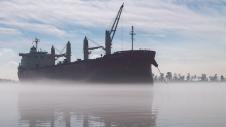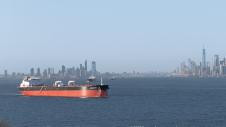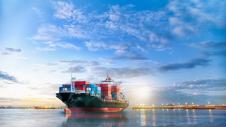The world’s post-COVID19 recovery, as welcome as it has been, has not been as uneventful as many people, ourselves included, thought it would be. Once there was a medical remedy to curtail the SARS‑CoV‑2 virus and people started socializing and traveling again, demand would have recovered, pulling along in tandem industrial production, and the world would have been sailing along to pre-pandemic levels, the prevailing recovery scenario held. And, based on broader consumption and demand, the recovery for the shipping industry was sure to follow.
More than a full year since COVID vaccinations rolled out globally, industrial recovery has not taken place as expected, in a linear fashion. No doubt that industrial recovery is back for all to see; however, bringing up production has been more complicated than just turning on more areas of the factory floor. And, shipping the end-products from the factory floor to the sales room has also been more complicated than loading more containers on ships. In other words, the road to recovery has been affecting the market as much as recovery itself.
The COVID pandemic brought along many subtle changes to our world, changes ranging in effect from people’s lifestyles to fiscal stimuli for global economies. More than two years later since the COVID started catalyzing these changes, still we have not managed to live with their impacts on the market.
With the lockdowns and work-from-home (WFH) mandates, consumers shifted their spending patterns from services to household items in order to make their confinement more bearable; once inventories at hand were depleted, overseas factory floors had to shift production to meet the new demand patterns. But, commodities and raw materials were not at hand, or harder to ship under port closures, which forced shippers to order more and with more lead-time, in order to pre-empty demand.
The pandemic allowed for essential transportation workers to report to work, but port operations (which depend on trucking, rail, etc and other complementary services) could not cope with new shipping patterns, which gave birth to the notorious port congestion problem at major port globally. Port congestion was further exacerbated by differentiated responses to COVID by authorities globally, most emphatically in Chinese ports (whereby single COVID cases in a port resulted in complete shut-downs of that port, no matter of the port’s trading volumes and global significance). Thus, instead of having a floating conveyor belt shipping containers from Asia (mostly China) to the West (US and Europe), that conveyor belt, besides the congestion at the receiving end, now could stop and start unpredictably, every time a government opted to act (pro- or re-act) to COVID cases.
With strong economic stimuli implemented by governments worldwide, with consumers having more disposable income to spend on products, and with shippers placing bigger orders and further in advance to catch up with pent-up demand, supply chains were stretched to the limit. The so-called bullwhip effect (an operations management term deriving from the magnified result of a whip whereby the end of the whip swings much broader than the handle of the whip) has verberated globally and had been felt from the coal mines of Indonesia to used car prices on Main Street. Additional exogeneous events (i.e. a colder-than-usual winter in Europe and Asia) and the invasion of Ukraine by Russia only brought more unpredictability, making any efforts to smooth the supply chain disruptions even more unattainable.
A profitable recovery
For the shipping industry, the recovery from the pandemic has been a mostly (very) profitable event. Whether for reasons of increased structural demand (i.e. demand for raw materials and commodities for the factory floor for the dry bulk market or demand for end-products via containerships) or for reasons of supply change disruptions (a ship waiting to dock to unload is a ship that cannot compete for new cargoes in the market, thus tonnage supply artificially dips), the COVID pandemic has meant higher employment for vessels, which led to better utilization rates and, of course, to higher daily rates. The containership market had it better than any other asset class in shipping, with neo- post-panamax containership vessels getting committed at $200,000 per diem (much higher than even in 2008, the market’s last major peak) and the Baltic Dry Index (BDI) having almost decupled in value between May 2020 (at appr. 487 points) and October 2021 (at 4821).
And, while shipowners and shipping investors (publicly listed dry-bulk and containership companies trade at record highs at present) enjoy the “ride”, one is left to wonder what’s next for shipping. Where do the supply chain disruptions stop and structural demand start? How much of today’s strong freight market can be attributed to inherent demand, and how much to just “noise” that will go away sooner or later?
And, once actual demand is quantified, how one can determine how such demand will change over time, in a world that seems to be piling up on risk? For starters, the war in Ukraine has introduced to the supply and demand equation, probably for the very first time in generations, the real possibility of a major world-wide war conflict, with or without nuclear weapons; and even if the war conflict is contained soon, still, as the Black Sea controls more than a quarter of the world’s grain exports, worldwide food supply concerns, but also inflationary concerns, cannot be ignored.
And, when it comes to inflation, the debate rages whether the world’s largest economy and the Fed lost the chance to tame inflation in the bud, and whether we are entering a new era of a higher inflation plateau and also a world of high interest rates; for a capital intensive industry such as the shipping industry, interest rates are of paramount importance. Higher inflation and higher interest rates would mean higher asset prices (that is vessels’ values), and as such, buying ships promptly, whether as new-buildings or in the secondary market, would make business sense.
But again, if for a recession scenario whereby demand dips and supply chain disruptions are not enough to artificially boost rates, then shipping may stand to see a noticeable downturn.
Setting the business course of the shipping industry has never been for the weak of heart. But, the unknowns presented now to the industry have moved beyond the standard supply and demand variables. Time will tell; time always tells!
*Basil M. Karatzas is the Founder of Karatzas Marine Advisors & Co and Karatzas Auctions, active in the maritime industry as financial advisors, shipbrokers and marine appraisers. Mr Karatzas is a Certified Marine Surveyor, an Accredited Senior Appraiser for marine assets, and a Fellow with the Institute of Chartered Shipbrokers in the UK.








